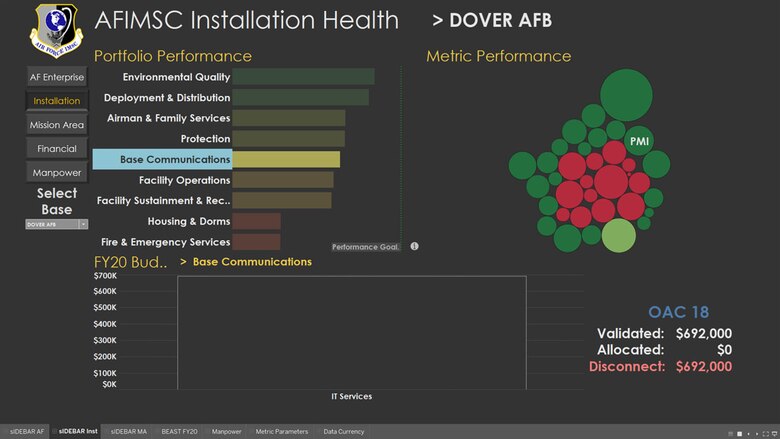Enhancements to the Installation Health Assessment analytics platform are giving Air Force commanders the ability to accurately prioritize funding requirements for more critical mission support areas.
Developed and launched by the Air Force Installation and Mission Support Center at Joint Base San Antonio-Lackland in August 2018, the IHA was initially designed to forecast facility and infrastructure funding requirements for Air Force bases. By April 2019, it featured 12 dashboards that supported six projects.
Since that time, the cloud-based platform has grown exponentially. Today, with more than 150 dashboards, commanders have access to the holistic site picture they need to assess performance in areas that include:
- Airman and family services
- Base communications
- Deployment and distribution
- Combat support
- Command support
- Environmental quality
- Facility operations
- Facility sustainment and recapitalization
- Fire and emergency services
- Force protection and security
- Housing and dormitories
From its inception, the IHA was designed with innovation in mind.
"Our long-term IT strategy called for automated processes that could efficiently collect, store and compute an immense amount of data from across the Air Force," said Marc Vandeveer, AFIMSC's Chief Innovation Officer.
AFIMSC partnered with the Air Force Chief Data Office, and on April 8, 2019, the IHA cloud-based platform launched. The Air Force CDO stores the data, which can then be moved in and out of a large capacity platform called a data lake.
"The data lake is robust enough to drill down and tell us the life cycle and replacement cost of an air conditioning unit at any facility on a particular base," Vandeveer said.
He added AFIMSC is currently addressing improvements to airfield management.
"We are jointly developing the Airfield dashboard that displays all condition data for every runway, taxiway and parking apron across the Air Force," Vanderveer said. "In addition to section-level details and maps, we have 10-year predictive degradation models that identify future requirements."
"We've worked hard to make it a tool for all the bases to use," said Patrick Kelly, chief of the Transportation Branch at the Air Force Civil Engineer Center operating location at Tyndall Air Force Base, Florida. "Integrating the PAVER Sustainment Management System with the IHA platform improved our ability to determine program requirements. Base pavement engineers can identify and project pavement repairs and then work with shops, base programmers and airfield managers to extend the life of their pavements."
The capability enables engineers and airfield management to effectively build a maintenance plan, with associated costs, to show stakeholders and leadership. In this way, they can efficiently support repair efforts, he added.
With more enhancements on the horizon, the IHA will provide automated subscription-based updates that supply customized reports to wings, major commands and higher Air Force- and Space Force-level organizations. This will include a bundled set of reports tailored for each installation.
Commanders at every level can accurately determine the overall health of their organizations, giving them the power to decide when and where to dedicate dollars.
"Predictive analytics help the Air Force plan for and spend dollars efficiently," said Gen. Tim Ray, commander of Air Force Global Strike Command. "Today, we're working closely with the U.S. Space Force on an evolving service-wide data lake. The challenge now is to work with each of the wings, groups and squadrons to make sure the data is reliably organized and readily available. If I had one extra dollar to spend, I would spend it on building the best data lake and analytical tools that I could."
Ultimately, these data-driven investment decisions optimize sustainment requirements and modernization efforts while mitigating risk.
"As we evolve, the IHA will continue to provide the enhanced visibility leaders need to invest the next dollar into their most important mission capabilities," Vandeveer said.

An Installation Health Assessment analytics report identifies portfolio performance for the various mission support functions at Dover Air Force Base, Del. Initially developed by the Air Force Installation and Mission Support Center, IHA tool enhancements provide Air Force commanders with the information they need to accurately prioritize funding requirements for more critical mission support areas. (U.S. Air Force courtesy graphic)






